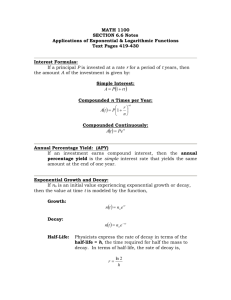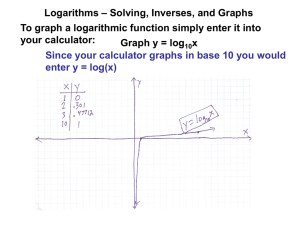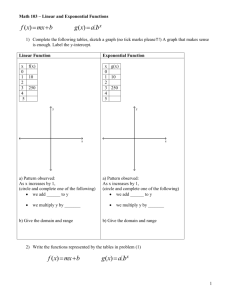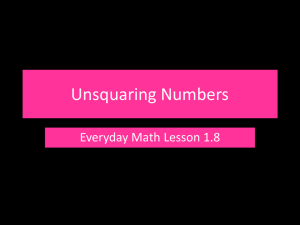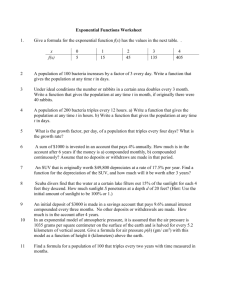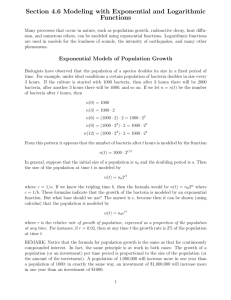Getting ready for Chapter 4.3 – 4.8 Exam Study all lecture notes
advertisement
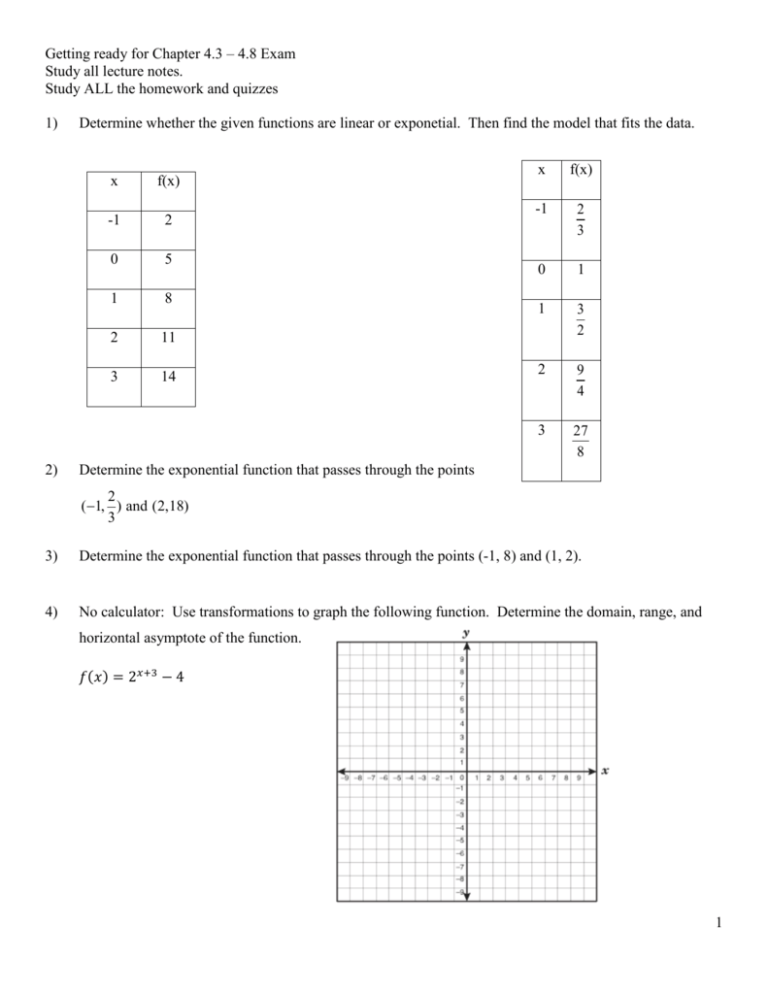
Getting ready for Chapter 4.3 – 4.8 Exam Study all lecture notes. Study ALL the homework and quizzes 1) 2) Determine whether the given functions are linear or exponetial. Then find the model that fits the data. x f(x) -1 2 0 5 1 8 2 11 3 14 x f(x) -1 2 3 0 1 1 3 2 2 9 4 3 27 8 Determine the exponential function that passes through the points 2 (1, ) and (2,18) 3 3) Determine the exponential function that passes through the points (-1, 8) and (1, 2). 4) No calculator: Use transformations to graph the following function. Determine the domain, range, and horizontal asymptote of the function. 𝑓(𝑥) = 2𝑥+3 − 4 1 5) Determine the exponential function whose graph is given. 6) You are given a graph or a table-of-values for the function f ( x) logb ( x) . Find b. a. b. x 0.05 1 400 2 5 f ( x) –1 0 2 1 2 c) ln( x) ln( x 6) ln( x 4) No Calculator: Solve: a) 25𝑥−1 = 8 8) No Calculator: Convert each exponential statement to an equivalent statement involving a logarithm. a) 52 = 25 9) b) 252𝑥 = 5𝑥 2 −12 7) b) 𝑥 6 = 200 No Calculator: Convert each logarithmic statement to an equivalent statement involving an exponent. a) 𝑙𝑜𝑔3 𝑦 = 7 b) 𝑙𝑜𝑔𝑏 16 = 3 10) No Calculator: Evaluate each expression. 1 a) 𝑙𝑜𝑔3 27 b) 𝑙𝑜𝑔2 (8) e) 𝑙𝑜𝑔3 8 · 𝑙𝑜𝑔8 9 f) 𝑙𝑜𝑔2 50 − 𝑙𝑜𝑔2 25 c) ln 𝑒 √6 d) 10log 50 11) No calculator: Given the function 𝑓(𝑥) = ln(𝑥 + 4) a) Find the domain of f. b) Graph f. c) Find f -1. d) Use f -1 to find the range of f. e) Graph f -1. *answer the above in any order* 2 𝐼 12) The decibel level, D, of sound is given by the equation 𝐷 = 10 log (𝐼 ), where I is the intensity of the 0 sound and 𝐼0 = 10−12 watt per square meter. If the shout of a single person measures 80 decibels, how loud will the sound be if two people shout at the same time? That is, how loud would the sound be if the intensity doubled? 13) The Richter scale is one way of converting seismographic reading into numbers that provide an easy reference for measuring the magnitude M of an earthquake. All earthquakes are compared to a zero-level earthquake whose seismographic reading measures 0.001 millimeter at a distance of 100 kilometers from the epicenter. An earthquake whose seismographic reading measures x millimeters has magnitude M(x), 𝑥 given by 𝑀(𝑥) = 𝑙𝑜𝑔 (𝑥 ) where 𝑥0 = 10−3 is the reading of a zero level earthquake the same distance 0 from its epicenter. a. If the seismic reading of the earthquake in Japan in 2011 was approximately 794,328 millimeters 100 kilometers from the center, determine the magnitude of the earthquake. b. Determine the seismic reading of the magnitude 7 earthquake that took place in Haiti in 2010. 14) Write each expression as the sum and/or difference of logarithms. Express powers as factors. a) 𝑙𝑜𝑔3 ( 𝑢𝑣 2 𝑤 𝑥√𝑥+1 ) b) 𝑙𝑛 ( 𝑥 2 −3 ) 15) Write each expression as a single logarithm. 3 a) 21𝑙𝑜𝑔3 ( √𝑥) + 𝑙𝑜𝑔3 (9𝑥 2 ) − log 3 ( 9) b) 𝑙𝑛 ( 𝑥−1 𝑥 𝑥 ) + 𝑙𝑛 (𝑥+1) − 𝑙𝑛(𝑥 2 − 1) 16) Use the Change-of-Base formula and a calculator to evaluate 𝑙𝑜𝑔2 21. 17) Solve each equation. Express irrational solutions in exact form and as a decimal rounded to 3 decimal places. (You may be asked to find the exact solutions to these types of equations without a calculator.) c) 𝑒 log𝑒2 49 a) 5𝑥+2 = 7𝑥−2 b) 𝑒 1−𝑥 = 5 e) 𝑙𝑜𝑔3 √𝑥 − 2 = 2 f) log(7𝑥 − 12) = 2 log 𝑥 d) 10𝑥−1 = −13 g) 𝑙𝑜𝑔6 (𝑥 + 3) + 𝑙𝑜𝑔6 (𝑥 + 4) = 1 h) ln(𝑥 + 1) − ln 𝑥 = 2 18) Solve by graphing: a. ln(2 x) x 2 2x b. e x 2 19) A child’s grandparents purchase a $10,000 bond fund that matures in 18 years to be used for her college education. The bond pays 4% interest compounded semiannually. 3 a) How much will the bond fund be worth at maturity? b) What is the effective rate of interest? c) How long will it take the bond to double in value under these terms? 20) If $1000 is invested at 5% compounded continuously, how much is there after 4 years? 21) How long does it take to triple your money if you can invest it at 4% compounded monthly? 22) If $3000 is placed into an IRA and it matures to $5000 in 5 years, what interest rate was offered if the interest was compounded continuously? 23) The number N of bacteria present in a culture at time t (in hours) obeys the law of uninhibited growth 𝑁(𝑡) = 1000𝑒 0.01𝑡 . a) Determine the initial amount of bacteria. b) What is the growth rate of the bacteria? c) What is the population after 5 hours? d) How long will it take the population to reach 1700? e) What is the doubling time for the population? 24) A culture of bacteria increases according to the law of uninhibited growth. a) If N is the number of bacteria in the culture and t is the time in hours, express N as a function of t. b) If 500 bacteria are present initially and there are 800 after 1 hour, how many bacteria will there be in 5 hours? c) How long is it until there are 20,000 bacteria? 25) A fossilized leaf contains 70% of its normal amount of carbon 14. How old is the fossil? Recall that 5600 years is the half-life of carbon 14 26) Radioactive cesium-137 was emitted in large amounts in the Chernobyl nuclear power station accident in Russia. The amount of a 100-milligram sample of cesium remaining after x years can be described by A( x) 100e0.02295 x . (Source: C. Mason, Biology of Freshwater Pollution.) a) How much remains after 50 years? What does this tell you about the half-life of cesium – is it more or less than 50 years? b) What is the half-life of cesium-137 4



